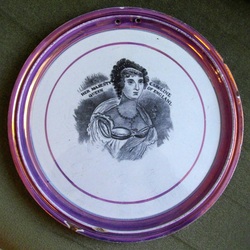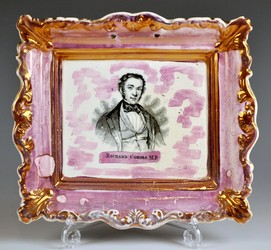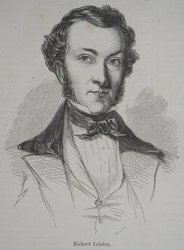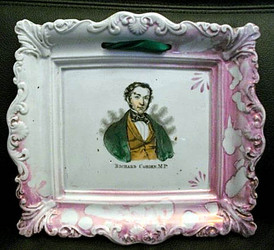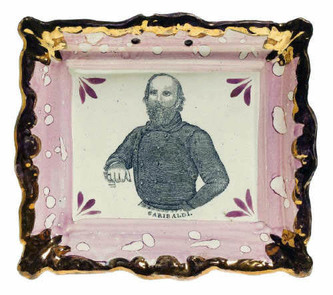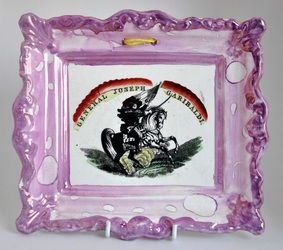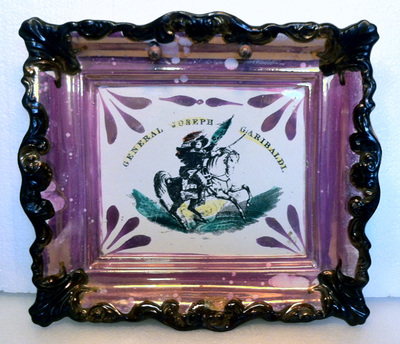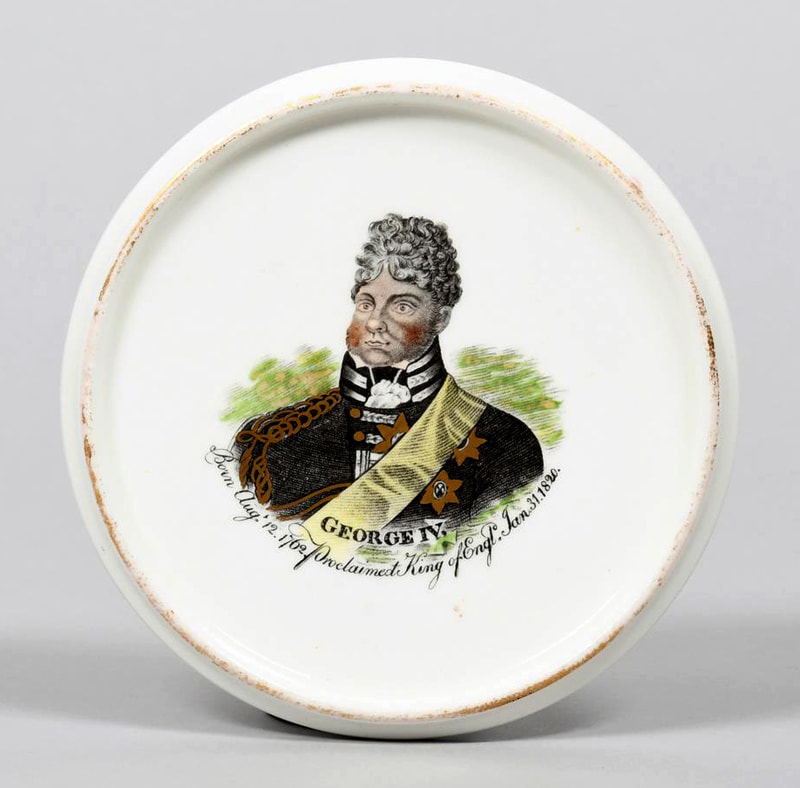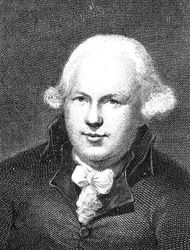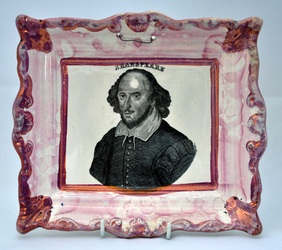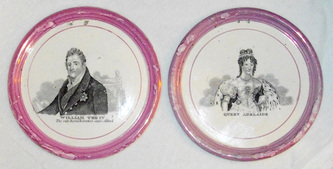Portraits
The two most common portraits found on plaques are those of John Wesley and Adam Clarke. You can see many examples in the pink religious and other religious sections.
Contents of this page:
Queen Adelaide
Robert Burns
Her Majesty Queen Caroline of England
Richard Cobden M.P.
Garibaldi
George IV
Earl Grey – First Lord of the Treasury
George Kinloch Esq M.P.
Rev John Knox
Father Michael Murphy
Sir Robert Peel Baronet
Robert Raikes
William Shakespeare
Spring and Langan
Queen Victoria
Hon. Charles Pelham Villiers, M.P.
King William IV
Queen Adelaide
Robert Burns
Her Majesty Queen Caroline of England
Richard Cobden M.P.
Garibaldi
George IV
Earl Grey – First Lord of the Treasury
George Kinloch Esq M.P.
Rev John Knox
Father Michael Murphy
Sir Robert Peel Baronet
Robert Raikes
William Shakespeare
Spring and Langan
Queen Victoria
Hon. Charles Pelham Villiers, M.P.
King William IV
Queen Adelaide
Both plaques have the 'C. C&Co' impressed mark for Cornfoot, Colville & Co. They are 170mm diameter. The plaques were made in 1831 when William acceded to the throne, and was crowned with Adelaide his Queen Consort. See 'King William IV' at the bottom of this page.
Robert Burns
Two unmarked plaques with features characteristic of Moore & Co, and a jug, both titled 'Robert Burns'. The painting below centre is the source for the transfer, by Alexander Nasmyth 1787 (National Galleries of Scotland). The plaques and jug almost certainly made in 1859 for the centenary of Burns' birth. In that year the Illustrated London News ran a Burns' centenary edition, and there were national celebrations to commemorate his life and achievements, including a poetry competition.
http://www.robertburns.org/
http://en.wikipedia.org/wiki/Robert_Burns
http://www.robertburns.org/
http://en.wikipedia.org/wiki/Robert_Burns
Her Majesty Queen Caroline of England
Richard Cobden M.P.
Richard Cobden MP was 'a radical politician and publicist. Cobden (1804–65) campaigned for free trade and was a leading figure in the Anti-Corn Law League from 1838. He entered Parliament in 1841 and his efforts contributed to the repeal of the Corn Laws in 1846. He was offered a cabinet post by Palmerston in 1859, but Cobden refused, preferring to remain independent. In 1860 he secured a reduction in trade tariffs between Britain and France.' (Baker, p 64.)
Baker gives a date of c 1840–50 for these plaques. However, the verse suggests they were made after the Corn Laws were repealed in 1846. The verse is transcribed on the poetic verses page.
Garibaldi
George IV
The right example has no holes for hanging, and is likely a teapot stand.
Earl Grey – First Lord of the Treasury
-REFORM.-
EARL GREY, steer'd his vessel well,
Through sea of factions storm;
And the people long shall tell,
of that gallant ship "REFORM"
http://en.wikipedia.org/wiki/Earl_Grey
EARL GREY, steer'd his vessel well,
Through sea of factions storm;
And the people long shall tell,
of that gallant ship "REFORM"
http://en.wikipedia.org/wiki/Earl_Grey
George Kinloch Esq M.P.
Made c1833 at the Ouseburn Pottery. The following biography of Kinloch is from the Scottish Parliament website.
George Kinloch (1775-1833) was known as the Radical Laird. In November 1819 Kinloch, who held liberal views, presided over a public meeting of the inhabitants of Dundee, held to protest the Peterloo massacre of August 1819. Two weeks after the meeting Kinloch was confronted with a warrant for his arrest, on a charge of sedition, issued on the authority of the Home Office in London. He was allowed bail, but after consulting his lawyers, was convinced that it was highly probable that he would be convicted for sedition and sent to Botany Bay. He decided that he had no alternative but to flee abroad. For the next three years (1820-2) he lived in exile in France. In 1822 Kinloch returned secretly to London and early in 1823 he returned clandestinely to Scotland. In May 1823, a pardon arrived and he was able to resume a normal life at Kinloch. In 1832 Kinloch was elected as the first MP for the new constituency of Dundee, which was created by the parliamentary reform bill of 1832. He took his seat in the House in February 1833, but did not enjoy his position for long as, in the following month, he caught a chill and died in London on 28 March 1833.
http://www.scottish.parliament.uk/vli/history/whisp/whisp-00/wh37-02.htm
George Kinloch (1775-1833) was known as the Radical Laird. In November 1819 Kinloch, who held liberal views, presided over a public meeting of the inhabitants of Dundee, held to protest the Peterloo massacre of August 1819. Two weeks after the meeting Kinloch was confronted with a warrant for his arrest, on a charge of sedition, issued on the authority of the Home Office in London. He was allowed bail, but after consulting his lawyers, was convinced that it was highly probable that he would be convicted for sedition and sent to Botany Bay. He decided that he had no alternative but to flee abroad. For the next three years (1820-2) he lived in exile in France. In 1822 Kinloch returned secretly to London and early in 1823 he returned clandestinely to Scotland. In May 1823, a pardon arrived and he was able to resume a normal life at Kinloch. In 1832 Kinloch was elected as the first MP for the new constituency of Dundee, which was created by the parliamentary reform bill of 1832. He took his seat in the House in February 1833, but did not enjoy his position for long as, in the following month, he caught a chill and died in London on 28 March 1833.
http://www.scottish.parliament.uk/vli/history/whisp/whisp-00/wh37-02.htm
Rev John Knox
The plaque has an indistinct mark for Wallace & Co.
Father Michael Murphy
Sir Robert Peel – Baronet
Sir Robert Peel (left) and his speech (right). See the poetic verses page for a transcription of the text.
http://en.wikipedia.org/wiki/Robert_Peel
http://www.historybookshop.com/articles/people/politicians-courtiers/peel-robert-death-of-ht.asp
http://en.wikipedia.org/wiki/Robert_Peel
http://www.historybookshop.com/articles/people/politicians-courtiers/peel-robert-death-of-ht.asp
Robert Raikes
William Shakespeare
The transfer's title is misspelt 'Shakspere'. This Moore and Co plaque was presumably made in 1864 to commemorate the tricentenary of Shakespeare's birth. Noel Riley (Gifts for Good Children,1790-1890) shows the print used on a school copy book dated 1856 and on a daisy plate, 'probably Moore & Co' (1189, p 292).
Click here to read about a link with Garibaldi.
Click here to read about a link with Garibaldi.
Spring and Langan
The circular plaque, the left hand rectangular plaques, and the two top illustrations show Tom Spring (February 22, 1795 – August 20, 1851). He was the bare-knuckle heavyweight champion of England from 1821–1824. Originally a butcher by trade with the surname 'Winter', Spring changed his name when he took up boxing professionally. In 1814 he met Tom Cribb, England's heavyweight champion, who became his patron. Lacking a strong punch, Spring is acknowledged as the first 'scientific' boxer. He fought defensively and developed a powerful left hook. In 1821 Cribb handed the championship to Spring, who saw off his first challenge, Bill Neat, in 1823. Spring twice fought the Irish fighter Jack Langan, beating him on both occasions. After his retirement he became landlord of the Castle Inn at Holborn, London, where he arranged many major boxing events. Langan is shown in the right hand rectangular plaques. The bottom left illustration is the source, but shows the mirror image.
http://en.wikipedia.org/wiki/Tom_Spring
The bottom centre plaque with both boxers is relatively large (13 x 16 inches) and, like the others, was made c1825 (the fight was on 7 January 1824). Black and yellow bordered versions also exist. A contemporary newspaper report of the fight is transcribed below.
The great fight between Spring and Langan for the championship, which is to be found commemorated by a print hanging up in almost every inn and public-building in England, took place in Pitchcroft, the ring being formed just opposite to the Grand Stand.
Considerably more than 150 guineas were paid to the managers of the fight to ensure its taking place at Worcester. The stakes were 300 guineas a side; and the betting two to one on Spring, who was a native of Warwickshire; while Langan was an Irishman.
Not less than 40,000 people thronged Pitchcroft as spectators, many being perched upon sheds and booths, erected temporarily, and let out as standing places at considerable prices. During the second round one of these erections gave way, and a number of persons were precipitated to the ground, a distance of twenty feet, amidst the broken timber, and trampling upon each other.
At least thirty people were carried to the Infirmary with serious fractures of the limbs or ribs, and one unfortunate fellow died of an unfortunate fracture of the leg.
Spring came on the ground at half-past twelve, but Langan could not be found for some time. He was, in fact, making off, and his backers brought him back with some difficulty.
Lord Deerhurst and Sir James Musgrave kept time; and Colonel Berkeley acted as umpire. Spring was exceedingly cautious, and Langan impetuous, and the greater part of the rounds ended in wrestling, in which Langan often succeeded in throwing his antagonist.
By the eighteenth round the ring was broken in by the crushing of the mob, and not ten feet of space was left for the men to fight in.
After an hour and a half’s fighting the affair seemed as little near conclusion as at its commencement.
At the eightieth round, Langan planted a tremendous blow on Spring’s head; but at the eighty fourth, Spring knocked Langan down with such terrific hits, that he fell as weak as a child.
The cry then became general to take him away, but although covered in his gore, he refused to give in, and was at last only removed by force.
The battle lasted two hours and thirty-two minutes – a most unheard of length of time.
At the next assizes, Mr. Justice Park, in his charge to the grand jury, administered a severe rebuke to the county and city magistracy for winking at, and permitting this affair.
http://elvillano.co.uk/2009/09/12/7-january-1824-%E2%80%93-a-famous-fight/
http://en.wikipedia.org/wiki/Tom_Spring
The bottom centre plaque with both boxers is relatively large (13 x 16 inches) and, like the others, was made c1825 (the fight was on 7 January 1824). Black and yellow bordered versions also exist. A contemporary newspaper report of the fight is transcribed below.
The great fight between Spring and Langan for the championship, which is to be found commemorated by a print hanging up in almost every inn and public-building in England, took place in Pitchcroft, the ring being formed just opposite to the Grand Stand.
Considerably more than 150 guineas were paid to the managers of the fight to ensure its taking place at Worcester. The stakes were 300 guineas a side; and the betting two to one on Spring, who was a native of Warwickshire; while Langan was an Irishman.
Not less than 40,000 people thronged Pitchcroft as spectators, many being perched upon sheds and booths, erected temporarily, and let out as standing places at considerable prices. During the second round one of these erections gave way, and a number of persons were precipitated to the ground, a distance of twenty feet, amidst the broken timber, and trampling upon each other.
At least thirty people were carried to the Infirmary with serious fractures of the limbs or ribs, and one unfortunate fellow died of an unfortunate fracture of the leg.
Spring came on the ground at half-past twelve, but Langan could not be found for some time. He was, in fact, making off, and his backers brought him back with some difficulty.
Lord Deerhurst and Sir James Musgrave kept time; and Colonel Berkeley acted as umpire. Spring was exceedingly cautious, and Langan impetuous, and the greater part of the rounds ended in wrestling, in which Langan often succeeded in throwing his antagonist.
By the eighteenth round the ring was broken in by the crushing of the mob, and not ten feet of space was left for the men to fight in.
After an hour and a half’s fighting the affair seemed as little near conclusion as at its commencement.
At the eightieth round, Langan planted a tremendous blow on Spring’s head; but at the eighty fourth, Spring knocked Langan down with such terrific hits, that he fell as weak as a child.
The cry then became general to take him away, but although covered in his gore, he refused to give in, and was at last only removed by force.
The battle lasted two hours and thirty-two minutes – a most unheard of length of time.
At the next assizes, Mr. Justice Park, in his charge to the grand jury, administered a severe rebuke to the county and city magistracy for winking at, and permitting this affair.
http://elvillano.co.uk/2009/09/12/7-january-1824-%E2%80%93-a-famous-fight/
Queen Victoria
Black and yellow bordered plaque titled 'VICTORIA'. This portrait of Queen Victoria was used on jugs, mugs and children's plates to commemorate her coronation in 1838. Look at the shape of the clouds in the top right, and you'll see the three plaques above have different transfers.
Hon Charles Pelham Villiers, MP
King William IV
The title reads 'WILLIAM IV The only Royal Reformer since Alfred'. Both the plaques above (left and right) have the 'C. C&Co' impressed mark for Cornfoot, Carr & Co. They are 172mm in diameter, and pair with Queen Adelaide (see centre image). The plaques were likely made in 1832 as they refer to Reform Act.







